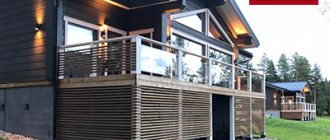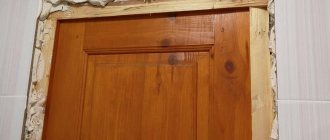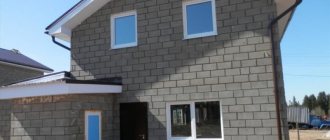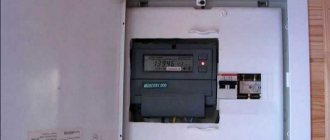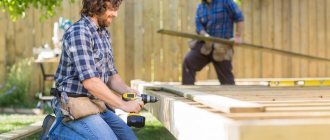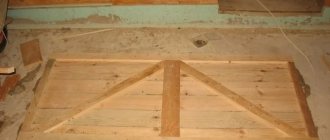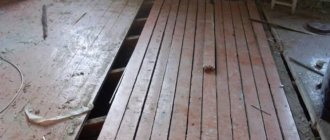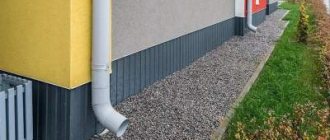During the construction of buildings from various types of wooden beams, situations arise when it is necessary to use not individual parts, but a composite element, since the length of the standard fragment is not enough. In this case, it is necessary to connect the beams together along the length.
This operation is quite often carried out if the wall of the building under construction is longer than six meters. In this article we will discuss the types of longitudinal connections of timber during the construction of a house, and also talk about how to carry out this procedure yourself.
Return to content
Tenon connection with dowels
Tenon connection with dowels
This type of merging of wooden elements is considered the most reliable and strong. It is what is most often used during the construction of buildings from various types of timber. The principle of connecting timber in this case is very simple - absolutely identical grooves need to be made in two elements. After this, the processed parts are placed next to each other so that the grooves touch and a key is driven into this groove.
The key is an insert element, a kind of wedge, which is made of hard wood. For wooden beams, you should use an aspen piece. After falling into the prepared grooves, this element securely fastens the two beams to each other. Keys can differ in geometric shape and be:
- straight;
- rectangular;
- with serrations;
- prismatic;
- in the shape of a dovetail.
Return to content
Basic information
One of the most proven methods of connecting two parts is considered to be a tongue-and-groove connection. This method of fastening wood products is the most widespread. It is used to fasten parts of window frames, doorways, various furniture elements, and the walls of wooden boxes. Each element of such products has a specially made tenon (or several pieces) or a groove (several grooves).
The types of main connections of parts made of wood are defined in GOST 9330-76. This document defines the following characteristics of such fastening of wooden parts:
- rules for abbreviation (abbreviation) of various compounds;
- drawings showing the appearance;
- permissible dimensions of each element;
- the procedure and rules for determining the size of each element;
- expressions for calculating the dimensions of the required cutting tool;
- formula for calculating the strength of assembled elements;
- inspection procedure and strength testing.
GOST 9330-76 Basic connections of parts made of wood and wood materials. Types and sizes
1 file 285.82 KB
According to this standard, all connections are divided into the following categories:
- corner (end and middle);
- box (mainly belongs to the corner category);
- along the edge;
- the so-called “on the mustache” length.
For each of these categories, the standard has its own abbreviation (short designation). This marking consists of two capital letters of the Cyrillic alphabet and one number. For example, UK-2 means that we are talking about a connection with a double open end-to-end tenon, UK-9 is a “mental” connection with a plug-in non-through round tenon. The entire list is set out in more detail in the text of the adopted standard.
Any type is accompanied by a detailed drawing. Each of them shows frontal and profile projections indicating dimensions, formulas for calculating each element, and finished results. To obtain a strong connection, the standard defines tolerances that must be observed in the manufacture of each element. The parameters of the corner tenon (its length, pitch and bluntness) are given in detail. Based on the results presented, the guest developed recommendations for choosing the necessary cutting tools. Separate references are made to other documents (standards) that determine by what means each of the listed products must be secured.
Types of finger joints
Today, a wide variety of such methods for fastening wooden parts has been developed. All types of tenon joints are classified according to the following criteria:
- number of spines;
- their form;
- eye depth (through or not);
According to the first sign, tenon joints are: single, double, multiple. It determines the number of fasteners produced. The main forms of the spike are:
- rectangular (has different lengths, pitch and apex angle);
- round;
- triangular;
- so-called “dovetail” (one-sided or two-sided);
- gear (with different angles of inclination);
- angular.
The choice of shape and size depends on the material used and the level of load that the entire structure must withstand. A tenon joint with many rectangular tenons has become widespread. Its main advantage is considered to be ease of manufacture and the ability to use it for any wood.
Connection in an oblique lock
Connection in straight and oblique lock
Experts call this splicing method the most difficult. Such a connection is extremely difficult for a person without the proper qualifications or experience. However, the reliability of the resulting design is really worth the effort. Companies that construct buildings from timber are well aware of how to join two timbers lengthwise using this method, but often keep silent about it in order to save time and maintain a high level of productivity.
So, first of all, you need to cut out the oblique elements from the ends of the wooden part. In this case, a certain angle must be maintained, the necessary bends must be repeated, and the dimensions must be fully consistent. The result should be some kind of tongue and groove, which ultimately form an oblique lock. After this, the two beams must be connected by placing the treated areas next to each other. To achieve maximum reliability and strength of the connection, special wooden dowels are used.
Return to content
The main advantages of a log house
Many houses made of wood have a problem with cold corners. This is due to poor thermal insulation. It is quite difficult to eliminate this phenomenon during operation, so insulation should be taken care of at the time of construction. The warm corner of a log house can be done in several ways. The basic principle of connecting a corner is the absence of any additional fastening elements.
The design itself involves reducing the contact of the surface of the timber with the environment. How to do all this with your own hands will be discussed below.
The simplest and fastest way is to install a warm corner made of timber using profiled materials.
The advantages of this design include:
- Strength - if all the necessary conditions during construction are met correctly, then the stability of the house will be at a high level;
- Low costs – this applies not only to finances, but also to labor. The absence of fastening elements simplifies the assembly process;
- Speed - the technology for making warm corners from timber is simple and high-quality construction does not require a lot of time;
- Thermal insulation - the main property of a log house is considered to be heat preservation; if you compare it with insulation materials (mineral wool, polystyrene foam), then with the same wall thickness a wooden house will be warmer;
- Exterior – a house built from profiled timber looks very organic and does not require additional processing or insulation from the outside.
Connection to root tenon
This type of connection is a key connection and it is also best to entrust it to specialists in this field. The fact is that the operation is not so much complicated as it requires the worker to be qualified and have certain skills in working with wood. To carry out this operation, you should cut a groove on one edge of the wooden element, and a tenon on the second. This must be done at an angle of 45 degrees.
This type of splice differs from all others in its shape. Most often, this method is used to arrange the corners of a building. The grooves and tenons are shaped very much like a trapezoid, and ultimately form a “dovetail”. To achieve greater strength and durability, the connection should be reinforced with dowels.
Connecting timber into a root tenon and analogues
It is important to know! If you use this type of splicing, it is important to ensure that one beam does not mix horizontally with the second.
Return to content
Cross Lap Knit
Lap knitting is a universal connection of lumber, used when laying walls made of logs and timber. The workpieces are placed at right angles into cut-out grooves; the size of this groove depends on the size of the material used. Such a lock is used in the construction of log houses and ceilings, the construction of bridges, and the construction of canopies. The main methods of cross fastening:
- Half-tree connection;
- Quarter and third wood joint;
- Notch in one row.
The most widespread cross-shaped connection in half a tree is when cutting corners into a bowl; it is used in the construction of utility structures, residential buildings and baths. The structure is reinforced with building brackets, dowels and dowels.
Wood floor splicing
This type of connection of wooden elements when constructing buildings from timber involves sawing out a corner in the timber to the middle of its cross section. One part should have a bittern with a downward angle, and the second one should have an upward angle.
After the preparatory procedures, the wooden elements should be laid on top of each other. The most important disadvantage of this type of connection is that in the places of splicing, the wooden beam significantly loses its thickness, which means its performance indicators drop.
Unlike the above methods, this one is the simplest. It does not require special training or extensive experience, so it can be done independently. After splicing the timber using this method, it should be additionally secured with wooden dowels.
Half-tree connection with an oblique cut
Return to content
Types of corner fastening with remainder
There are the following methods of corner installation with remainder:
- “in a state of rage”;
- “half a tree”;
- "in the fat tail."
To make it clear, let's look at the options in more detail.
"To the brink"
This type of installation involves the presence of two semicircular bowls (for logs). When assembling a log house from a log, this method is also called “in a bowl”. That is, symmetrical recesses are formed, the depth of which is ¼ of the section of the beam, and then the parts are connected according to the lock principle.
"Half a Tree"
Half-tree installation is the simplest type of fastening. It implies the presence of not only a bowl, but also a longitudinal groove filled with insulation - jute, moss or linen. The structure is reinforced with nails or staples. The structure is airtight.
"In the fat tail"
Installation “in the fat tail” presupposes the presence of a transverse recess, groove, mini-protrusions located inside the bowl-pothole, facilitating the construction of a reliable structure.
Attention! Any method, if desired, can be reinforced with a dowel - this is a cylinder-shaped dowel made of durable wood. It is mounted vertically into a drilled groove between the rims. The dowel makes the structure more stable. Long metal pins are often used for these purposes.
Splicing by application
This splicing method is perfect for those who are not very concerned about the appearance of the structure, as well as its durability. Its principle is to attach two beams to each other and apply a metal bracket to the joint. Of course, this splicing method cannot be called super-strong, so it needs to be reinforced. To do this, fasteners are used that are hammered into the already laid row of wooden elements, as well as into the contact zones.
By following this link you will learn how to attach timber to timber. This article describes how to attach timber to the base of a house. Recently, the construction of houses from timber has become very popular.
Now you know how to connect timber together along the length in various ways. Now let's talk about how to choose the right method for connecting wooden elements.
Return to content
Video description
This video shows how to make a groove on the end of a beam using a template and a chainsaw:
If the structure of spliced beams does not require the formation of smooth edges, they can be overlapped, tightened with nails on both sides or metal pins at several points. This is often done when you need to lengthen the rafters. Or get powerful logs or floor beams by merging two beams not only in length, but also in thickness. In such cases, before joining the timber, the joints must be shifted relative to each other.
How to choose the right connection
Connections that do not require calculations and skills can be made independently, but this method of splicing is not very strong and durable. Of course, it can be strengthened using special fasteners, which we wrote about above, but stronger connections still benefit in terms of performance characteristics.
Due to their relatively low strength, such connections cannot be used for the construction of load-bearing wall structures. Any professional builder will not use material with a non-solid structure for such purposes. Only if you neither order nor purchase wooden elements of the required length, longitudinal connections are allowed. However, in this case, the structures lose some of their parameters, including durability.
Correctly connected beams
For the construction of buildings from laminated veneer lumber or any other timber, splicing with tenons and dowels is best suited. The resulting structure is almost as good as a solid wooden piece, so it can be used for any purpose. The connection is rigid and durable, and therefore can last for quite a long time.
It is important to know! In this type of splicing, the fastener – the key – plays a huge role. Therefore, when choosing it, you should not chase cheapness, but buy a truly high-quality product.
Due to the high degree of rigidity of the connection, as well as its reliability, many experts recommend splicing into an oblique lock. The resulting timber after joining can be used for the construction of load-bearing wall structures. The only problem you will encounter is the complexity of the work.
For such a connection, you will need an experienced worker who knows how to use all the necessary tools, and if you are not one, then it is better to leave this idea. A qualified specialist is able to carry out such a splice, but he will require about 1,100 rubles for one connection. On the other hand, these costs can be recouped, since you will not have to order new wooden elements of non-standard length.
Return to content
Half swallowtail
With this connection, the tenon is sawed down into a cone. The characteristics of the half dovetail connection do not differ from the knot described earlier. But the strength indicator increases. The conical cut securely holds the beams and prevents them from moving apart. This connection is used in the construction of walls with a length greater than the length of the beam.
There is no difference in the complexity of manufacturing when joining a half dovetail and a straight tenon. Both methods are performed with or without a template. For an experienced professional, the difference in the labor intensity of making these joints is almost imperceptible.
The half dovetail tenon should not be more than 5cm at its widest point. Otherwise, a crack will appear in the timber with the groove. This happens due to uneven shrinkage. The picture shows this place.
Features of joining profiled material
Contrary to popular belief, profiled material can also be joined along its length. All aspects of such operations are regulated by GOST 30974-2002. The requirements given in this documentation cannot be considered mandatory. They are rather used for corner or shaped connections of profiled wooden elements.
It is important to know! When purchasing material, be sure to ask the seller for a quality certificate, which will confirm that the material meets the requirements of GOST.
Connection of profiled timber
According to these documents, spliced profiled timber can be used for the construction of the following structures:
- internal wall structures, as well as all simple partitions (the length of the timber is from 8 to 22 centimeters);
- external load-bearing wall structures (the length of the timber is from 10 to 2 centimeters).
The connection of profiled timber along the length requires the presence of chamfers in this design. They are needed to drain liquid from the joints. These elements should have dimensions of 2 by 2 centimeters or 1.5 by 1.5 centimeters. As a rule, professional builders use dovetails to join wooden elements of a building under construction.
Return to content
Types of corner fastening
You can connect the material at the corners thanks to two options:
- with remainder - implies the use of longer raw materials than required for the construction of the facility;
- without residue - assumes the presence of perfectly even corners in the structure.
Practical point of view
The remains of the material are entrusted with a responsible mission - protecting the timber from the destructive effects of climatic factors - precipitation and wind. However, this design is expensive due to the higher consumption of raw materials and is troublesome.
An object with perfectly even corners is susceptible to the destructive effects of climatic manifestations. But its construction is quite simple and cheap compared to the previous version.
Aesthetic point of view
A structure with remains looks much more attractive than without them, since it is associated with a welcoming hut or a luxurious tower. And what style do you think has the golden trident of power on fashion Olympus? Right! Russian direction.
What you need to know for do-it-yourself longitudinal joining
As we said above, the need to connect wooden parts when constructing a building from this material appears when the design documentation provides for the construction of one or more wall structures more than 6 meters long. The binding must be done first on one side, and in the next row on the other, and so on until the end.
This is necessary to obtain an attractive and original appearance, because joints that are staggered look more interesting than those in a row. In addition, this arrangement makes the entire wall structure much stronger and more durable.
When choosing a method for connecting wooden elements, you should pay special attention to exactly how the beam is located in the building structure. The whole problem is the load on these elements, because in different parts of the wall it can be different, for example, a beam can be subject to tension, compression or deflection.
Types of longitudinal connections
All additional fasteners must be made exclusively from hard wood. The humidity of these elements should correspond to the humidity of the timber itself and not exceed five percent. If the parts have more or less moisture than the material itself, the connection will be weak or the part may damage the material.
Each joint must be perfectly level. Before laying the jointed beams, it is necessary to saturate them with antiseptic compounds and allow some time to dry.
Each joint, including corner or longitudinal, must be insulated with a layer of heat-insulating material. This procedure is best done during installation. To do this, it is enough to cover the joint with flax fiber.
It is very important to remember the moisture content of the material during splicing work. If you overdry the products, then after some time significant defects may form in the joints, which will entail extremely unpleasant consequences. Additional reinforcement of joints must be carried out with special responsibility.
If we are talking about profiled material, then in this case it is better to use such types of connections as a tenon or an oblique lock. This way the wall structures will not lose their reliability. And if all the work is done meticulously, the connecting nodes will not only be reliable and safe, but also attractive in appearance. Now you know how to connect a beam in length and you can cope with this task without the involvement of craftsmen.
Return to content
Key points
When erecting walls, the task of joining arises in two cases: when building up (weaving) material along the length and connecting the corners of the building.
The joining of the timber in the corners is of greatest importance. During its implementation, the reliability of the house, its size, design and quality of the wall are laid down. There are two types of connections: without remainder and with remainder. The latter is based on the fact that the end extends to a set length beyond the corner fastening site. The peculiar wooden insulation of the corner, especially noticeable during windy times, is the main advantage of this method. In addition, thanks to this execution, an original design is created that has its own connoisseurs.
By interweaving without a trace we mean the arrangement of the ends at the same level with the plane of the wall. The main advantage is saving building materials and reducing the size of the building.
For any type of product, the connection rules are general; it can be profiled or laminated timber 150x150, dried or with natural moisture. During the installation of a log house, the same method should not be used. Different structural elements have their own fastening methods. When purchasing materials, it is worth remembering that samples for good insulation must have different sizes, in particular cross-sectional parameters.
Requirements for timber for building houses: dimensions, characteristics, properties
As a rule, joining of profiled timber is performed for material with the following characteristics:
- for external walls from 100 to 260 mm;
- for internal walls or partitions from 80 to 220 mm.
On the front part, the timber must have special chamfers along which rain and melt water are drained; their optimal size is 20x20 mm, but 15x15 mm is also allowed.
The quality characteristics of dowels or dowels are also of great importance. You should pay attention to the humidity parameter; it should be lower than 2-5% than the humidity of the material itself. To calculate the required amount of timber, use the calculator:
Fastening timber: tool
Connecting timber is not the most difficult and difficult task. But you should prepare. To do this you will need:
A measuring tool (tape measure, carpenter's corner, level) and a pencil, with their help the marking of the forming surfaces of the fastening is carried out.
Saw, possibly a hand saw
or chain with electric drive,
but it is better to use a mechanism with a gasoline engine;
Hammer, drill and screwdriver.
Furniture, railings
The instructions for splicing bars when making furniture or fencing yourself inside a house are noticeably different from the recommendations that are relevant for rafters or beams. In this case, aesthetics come first.
How can you make a connection with your own hands that will be not only durable, but also beautiful? We have already studied the technique itself: tenons are formed at the ends of the parts by milling, after which they are glued end to end.
Let us remind you: pressing is mandatory and should take at least 5-6 seconds. Then the part is fixed in a stationary position while the glue dries.
Cutter for picking out tenons. The price of the product is from 200 to 800 rubles, depending on the size.
However, the result greatly depends on a number of subtleties.
- The block is selected according to color and texture;
- The type of wood must be the same. Humidity can vary by up to three percent;
- Defects on the elements being joined must be located on one side - the back;
- No more than a day should pass between cutting the tenons and gluing. Otherwise, uneven drying of the wood will affect the accuracy of the fit of the tenons and the quality of the adhesive seam;
- Excess glue squeezed out during pressing is removed immediately. Once it dries, it will be much more difficult to clean the part.

